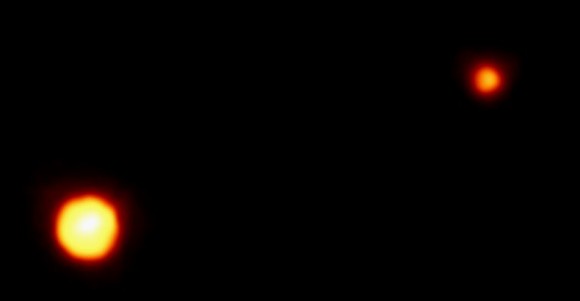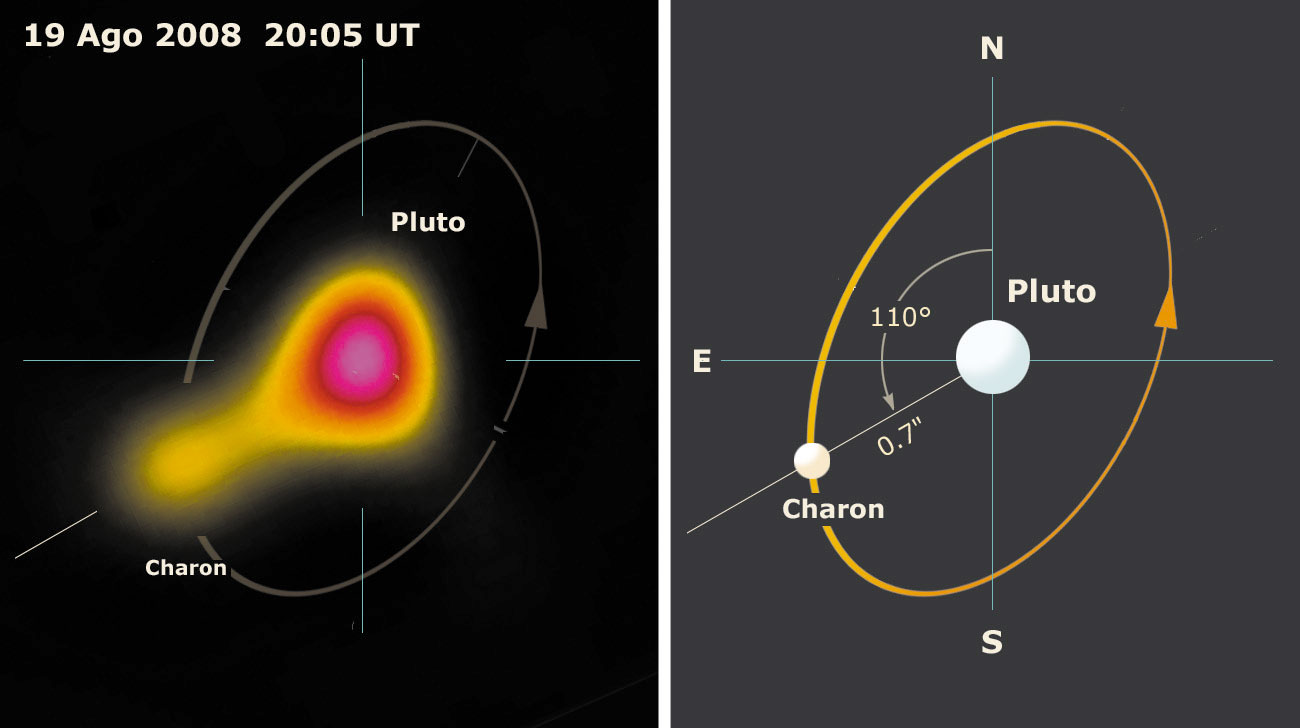[/caption]
This past summer, a group of seven amateur astronomers from Italy worked on an observation campaign of Pluto, with hopes of capturing an image of its moon, Charon. “Imaging Charon is very difficult and nobody has spotted it with amateur equipment, so far,” said Daniele Gasparri, one of the members of the group. The team made several attempts, and finally, one member of the group, Antonello Medugno, took this interesting image. “After many calculations,” said Gasparri, “we are sure that this image shows clearly Pluto and Charon, for the first time with amateur equipment.” Comparing the image to the graphic which shows the position of Pluto and Charon on the same date, it’s obvious, they nailed it! This is quite a feat considering their equipment was an “amateur” 14-inch telescope! Also, as The Bad Astronomers points out, Charon wasn’t discovered until 1978, and then a 61-inch telescope was used!
Compare their image to one taken by Hubble:

Not bad!!
Gasparri is an astronomy student, and a contributor to the Italian astronomy magazine Coelum. With the support of the magazine, he coordinated the effort to image Charon. Medugno used an 14″ Schmidt-Cassegrain telescope, a Starlight Xpress SXV-H9 CCD camera and a R-IR passband filter.
The image was processed using the Lucy-Richardson Algorithm of the RAW image, composed of 21 frames of 6 seconds of exposure each, with a focal of 8900mm. “All data confirm the image: the magnitude, separation, and position angle,” said Gasparri. Nice work! Check out Gasparri’s website of more astronomical images he has taken.


That’s truly amazing. With off-the-shelf equipment and a little know-how, amateur astronomers can do things professionals struggled with only 20-30 years ago.
With this kind of capability, a motivated amateur can do real science. And no doubt there are many simple and beautiful things left to discover… even with a modest telescope.
Great article!
has anyone tried yet to detect Nix and Hydra with amateur equip? is it possible?
They need a bigger telescope in order to do that. Besides, these two moons were discovered only a few years ago by Hubble Telescope (?); I think it will take at least 10-20 years for ordinary amateur astronomers to do that in the future.
Another interesting situation is that amateur astronomers take some images of extrasolar planets !!! How long will it take them to do that? Any guess?
well, if the trend continues, and Nix and Hydra will take about 10-20 years, we should have an amateur image of an extrasolar planet as soon as adaptive optics become commercially available…maybe, 30-40 years?
We should redefine what an “amateur” is and what “amateur equipment is”.
Most major observatories have at least a few C14’s that are used routinely for astronomical observations. That is the SCT that we are talking about here.
There is no such thing as AMATEUR EQUIPMENT or PROFESSIONAL EQUIPMENT. Amateurs use the same equipment that Professionals use and visa versa. … it is really about who pays the bills and that person or corporation or gov’t that does pay the bills determines the goals and priorities for the equipment.
Some of these so called “amateurs” must have VERY DEEP POCKETS to be able to afford such equipment and a permanent observatory from which to use that equipment and the time to wait for the right conditions and such to attain images. What is the real difference between a professional and an amateur? A degree – hogwash – the discoverer of Pluto had no degree. A funding source – yes but some of todays so called amateurs have much higher budgets than many professionals and these amateurs have no need to make a case for the acquisition, use, or priorty for the equpment.
In many cases … so called amateur equipment is superior to professional equipment of just a couple years ago because professional observatories have limited resources as well. In many cases, amateurs and professionals use the same equipment … exactly.
It really is all about $$$$. Almost any group of amateurs with enough $$$ can achieve the same results as professionals. In past times, so called “amateurs” built many of the great observatories that “professionals” use every day.
But … are they really amateurs anymore. Do they really work 40 hours a week in non-astronomy professions or do they have a magnifient pile of money or an endownment so they can focus on astronomy without worrying about the day-to-day issues of ekeing out a living. Who can afford such equipment and time without an outside benefactor (or an inheritance) to pay some or all the bills and expenses.
It really comes down to $$$. Those of us who don’t have large budgets to commit to astronomy still make achievements as amateurs. Those with large budgets … well they really are professionals.
For these so-called “professional amateurs”, astronomy is an Avocation if not a vocation.
Many of us with significant investments just can’t manage the $$$ to become a “professional amateur”
How much money for a 14 inch telescope?
Found my answer, anywhere from $6000-$10,000.
Amazing work. Top job guys…
# Zibit Says:
October 30th, 2008 at 3:01 pm
How much money for a 14 inch telescope?
# Zibit Says:
October 30th, 2008 at 3:12 pm
Found my answer, anywhere from $6000-$10,000.
Actually, a ~14 inch instrument or similar can be found in a much wider price range than that – the price all depends on the ultimate quality and capability of the instrument. For example, a 12.5 inch scope from a premium manufacturer such as RCOS, optical assembly only, will set you back more than US$20,000. A 16 inch Meade Lightbridge can be had for under US$2000… Mind you, you won’t be imaging Charon with the ligthbridge. If you did, you’d be quite the hero…
>and @ Steven C Says:
October 30th, 2008 at 1:02 pm
I would agree with you largely about the equipment being similar in some cases – there is some overlap between lower end professinal setups and very high end amateur setups. Certainly you can find pro’s using RCOS scopes and even some of the higher end Meades, etc. But what separates a professional astronomer from an amateur? A pro astronomer gets paid to do what they love, whereas an amateur does not. Simple really, when it comes down to it…
I know very little about astronomy and perhaps the answer to this question is obvious to everyone, but why couldn’t Hubble image Charon? Is it too close?
So where is his image? I see a nice pretty HST image and some false color image that is marked up at the top. Is that his image after processing on PC?
“why couldn’t Hubble image Charon? Is it too close?”
Hubble can image Charon. The bottom image is a HST image. I don’t know what the blob in the top image is.
@ Bob & ruf, check out the Bad Astronomy link in the story for a more complete description of the equipment and techniques used to make this amazing image. This is the real thing, heavily processed of course, but the real deal nonetheless.